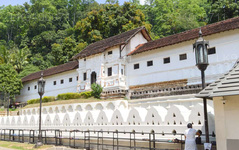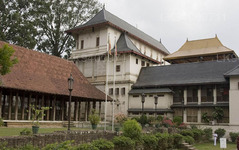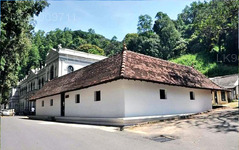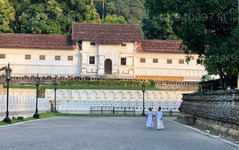
Kandy City
Kandy, a picturesque city in central Sri Lanka, is renowned for its rich cultural heritage, vibrant festivals, and scenic beauty. Nestled amidst lush hills, it is home to the Temple of the Tooth Relic, a UNESCO World Heritage Site, and offers a captivating blend of history and natural splendor.
Royal Palace Kandy
The Royal Palace of the Kingdom of Kandy was the last Royal Residence of His Majesty King Sri Vikrama Rajasinha (1798-1815). The Palace is situated to the North of the Dalada Maligawa Temple in Kandy. The first Royal Palace in Senkadagala was built by King Vickramabahu III of Gampola (1357-1374) on the advice of a Brahmin who selected the site as a lucky ground for a Capital city. The original palace has been burnt and destroyed several times and it was rebuilt by subsequent kings. In ancient times the Royal Palace was called “Maha Wasala” or “Maligawa”. The section of the Royal Palace facing the Natha Devale is said to be the oldest part. During King Vimala Dharma Suriya I (1592-1603) was also his royal residence and he made various improvements to the Royal Palace. During the reign of King Senarat (1603-1634), the Portuguese attacked the Kingdom of Kandy and destroyed the Royal Palace. King Rajasinghe II who accented to the throne in 1637 rebuilt it and all the subsequent kings used this as their Royal Residence.
After the British invasion in 1815 the Royal Palace of the Kingdom of Kandy was used by the British Government Agent Sir John D'Oyly and his successors have continued to use it as their official residence. Only the front entrance of the royal palace with a few buildings remaining and today it is preserved as an archaeological museum.
Raja Wasala (King’s Palace)The Raja Wasala (King's Palace) is a long building with a central doorway and a flight of steps entering into an imposing hall decorated with stucco and terra-cotta work. Rooms are found in the two long wings with a long verandah facing the inner courtyard.
Meda WasalaTo the north of the Palle Wasala, is the Meda Wasala or Queens' Chambers. Although smaller in size, it is similar in architectural character to the Palle Wasala. The building is currently used by the Kandy office of the National Department of Archaeology.
Wadahindina MandappeThis is where the king used to meet Adigars and other foreign envoys and visitors. It is situated near the Raja Wasala and Magul Maduwa. Today this building is used as the museum building for ‘Raja’ the Maligawa tusker.
Palle WasalaThe Palle Wasala or Lower Palace was used as the quarters of the harem of the King of Kandy. The main doorway to the structure leads to a small hall in front of the central building. In 1942 this building was converted into the National Museum of Kandy, and is currently maintained by the Department of National Museums.
About Kandy District
Kandy district is situated in the centrel province of Sri Lanka. One of the seven World Heritage Sites in Sri Lanka, Kandy was once home to the Kandyan Kings of yore in the 16th-century and a fountainhead for all the music, arts, crafts and culture in the country. About 129 km away from Colombo, Kandy is ensconced amongst a hilly terrain and all eyes are drawn to the centre of the city, where the Kandy Lake forms a charming feature. Kandy retains great religious significance for Sri Lanka, because it is in this charming city that the Dalada Maligawa or "Temple of the Tooth" is located, within which the sacred tooth relic of Lord Buddha lies well guarded.
The Royal Botanical Garden, Peradeniya is situated about 5 km to the west of the city centre at Peradeniya and is visited by 1.2 million people per year. It is the largest botanical garden on the island. The Udawatta Kele (Udawatta Forest) is a protected sanctuary situated in the heart of the city, just north of Temple of the Tooth.
Kandy is a Sinhala majority city; there are sizeable communities belonging to other ethnic groups, such as Moors and Tamils. Kandy is second only to Colombo the center of the Sri Lankan Economy. Many major co operations have large branch officers in Kandy and many industries include textiles, furniture, Information Technology and jewellery are found here. Many agriculture research centers are located in the city.
And a fountainhead for all the music, arts, crafts and culture in the country. About 129 km away from Colombo, Kandy is ensconced amongst a hilly terrain and all eyes are drawn to the centre of the city, where the Kandy Lake forms a charming feature. Kandy retains great religious significance for Sri Lanka , because it is in this charming city that the Dalada Maligawa or Temple of the Toothis located, within which the sacred tooth relic of Lord Buddha lies well guarded.
About Central Provincce
The Central Province of Sri Lanka consists primarily of mountainous terrain. The province has an area of 5,674 km², and a population of 2,421,148. Some major towns include Kandy, Gampola (24,730), Nuwara Eliya and Bandarawela. The population is a mixture of Sinhalese, Tamil and the Moors.
Both the hill capital Kandy and the city of Nuwara Eliya are located within the Central Province as well as Sri Pada. The province produces much of the famous Ceylon tea, planted by the British in the 1860s after a devastating disease killed all the coffee plantations in the province. Central Province attracts many tourists, with hill station towns such as Kandy, Gampola, Hatton and Nuwara Eliya. Temple tooth or Dalada maligawa is the main sacred place in Centrel province.
The climate is cool, and many areas about 1500 meters often have chilly nights. The western slopes are very wet, some places having almost 7000 mm of rain per year. The eastern slopes are parts of the mid-dry zone as it is receiving rain only from North-Eastern monsoon. The Temperatures range from 24°C at Kandy to just 16°C in Nuwara Eliya, which is located 1,889 m above sea level. The highest mountains in Sri Lanka are located in the Central Province. The terrain is mostly mountainous, with deep valleys cutting into it. The two main mountain regions are the central massif and the Knuckles range to the east of Kandy.





























